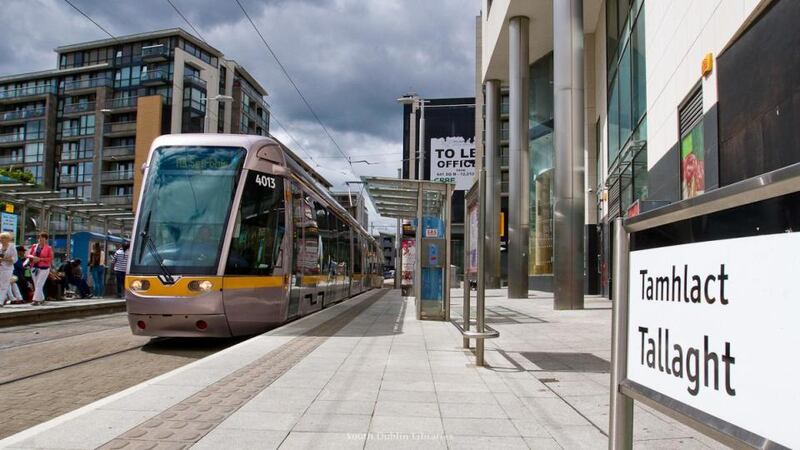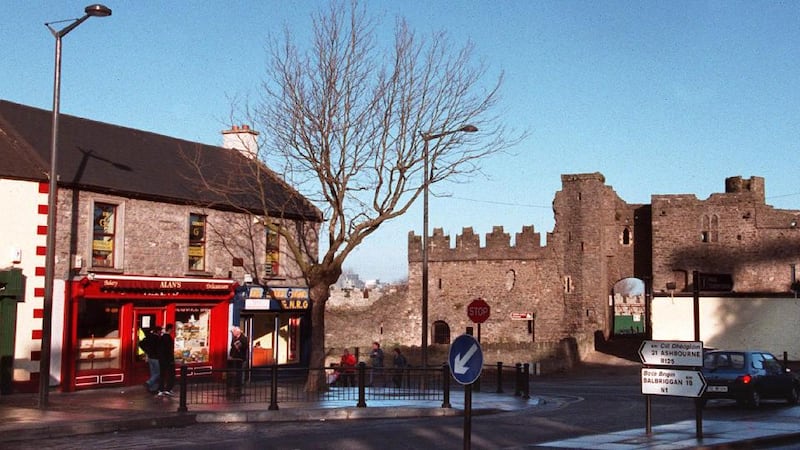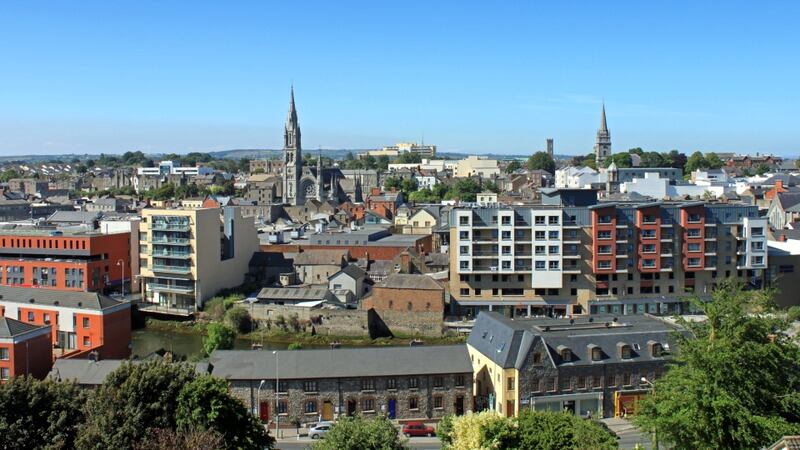In Dublin, Tallaght has emerged as the most popular location for first-time buyers spending up to €450k in 2016, followed closely by Swords and Lucan. The remainder of the top-ten best selling first-time buyer locations in Dublin are split between three in north Dublin city: Finglas, Castleknock and Clonsilla; two in south Dublin city: Clondalkin and Rathfarnham; and two in north County Dublin: Malahide and Balbriggan.
Top ten neighbourhoods in Dublin for first-time buyers in 2016 (based on sales)
1. Tallaght
2. Swords
3. Lucan
4. Finglas
5. Castleknock
6. Clonsilla
7. Clondalkin
8. Rathfarnham
9. Malahide
10. Balbriggan
0 of 3
Source: CSO/Myhome.ie
Jump to our neighbourhood guides on desktop: Tallaght ¦ Swords ¦ Drogheda
Outside the capital, perhaps unsurprisingly, Dublin commuter counties Louth and Wicklow top the list with most sales in Drogheda and Bray. Louth features again in the top ten with Dundalk, while Leinster continues to dominate with Newbridge in County Kildare and Navan in County Meath, as well as Kilkenny and Wexford. The list is completed by three locations in Munster: Midleton, Co Cork; Waterford City; and Ennis, County Clare.
Top ten neighbourhoods outside Dublin for first-time buyers in 2016 (based on sales)
1. Drogheda
2. Bray
3. Dundalk
4. Newbridge
5. Navan
6. Kilkenny
7. Wexford
8. Midleton
9. Waterford City
10. Ennis
Source: CSO/Myhome.ie
In this, the first in a short series we will analyse why first-time buyers are choosing these new neighbourhoods and explore what they have to offer. This week we focus on Tallaght, Swords and Drogheda.
The upturn in the Irish economy has coincided with a growth in the number of first-time buyers, with prices now competitive yet reasonable for those seeking to make a purchase.
“We’ve seen an upturn since 2013, following the peak in 2007 and subsequent collapse, which reached a bottom in 2012,” says John O’Beirne, head of mortgages at Bank of Ireland.
“The resurgence is Dublin-led with a 5 per cent increase last year and a bit more nationally. There is an increased confidence and demand, but supply has been the concern.”
This shortage in traditionally strong areas such as Dublin 6 and Dublin 6 West - has led directly to the increase in sales in alternative areas since 2013.
We try and offer practical support for first-time buyers at every step of the mortgage journey
“If you look at Dublin for example, the shortage has led to a growth in sales in commuter counties in places like Louth and Kildare,” says O’Beirne. “In Dublin itself, you are starting to see a spread out of the more traditional areas into new neighbourhoods, areas like Tallaght in particular are showing strong growth.”
Bank of Ireland prides itself on being a bank that can provide deals for first-time buyers that are better than their competitors, with a number of incentives in particular backing this assertion including up to 3 per cent cashback which has recently been extended to the end of November.
“We try and offer practical support for first-time buyers at every step of the mortgage journey,” says O’Beirne. “Last year we ran 17 of our Dermot Bannon mortgage events across the country to help first-time buyers better understand the process.
“Last year we launched a full mortgage service over FaceTime and Skype, because it doesn’t always suit to come to a branch in a traditional way. As well as our phone and digital options, we’ve also made sure our mortgage advisors are now out and about and will come and meet customers wherever they are.

TALLAGHT, SOUTH DUBLIN CITY
Dublin 24 is experiencing a boom in sales, with Tallaght the epicentre of that increase. There is a spread of housing types and styles in the area, but with 80 per cent of properties for sale listed as houses, as opposed to apartments, the area is ideal for small families, or couples looking to begin a family within a few years of moving into this part of south Dublin.
"Tallaght is ideal for commuting to the city centre, but it's also got great employment options locally," says Arwel Buckland, Bank of Ireland Tallaght commercial branch manager. "You have Tallaght IT, Tallaght Hospital, South Dublin County Council, the Synergy Centre and LIDL Head Office.
“A lot of investment over the last number of years has led to the development of a number of high-quality properties. We are a community bank and we help local people to go through the whole mortgage process locally from start to finish. We see a lot of local walk-ins and we also go out into the Tallaght community to help local buyers. That’s the key thing about why Tallaght is so popular, in fact. There is a real community spirit and that helps to make the area such a desirable place to live.”
The availability of starter homes, which offer exceptional value in the always-competitive housing market in Dublin, means Tallaght tops the list for first-time buyers in the capital, according to Richard Mullan of Murphy Mullan Estate Agents.
“Values in Tallaght are more accessible to first-time buyers than anywhere else in Dublin at the moment. That extra bit of value for money makes it more attractive to buyers, especially first-time buyers,” says Mullan. “Tallaght stretches from the roundabout at the M50 right through to Saggart and Rathcoole, even though they’re not quite Tallaght, but it’s a huge area. So you have a very mixed bag of properties from local authority properties at less than €200k and more expensive properties in the high €400k range, pushing out towards Citywest and Rathcoole.”
Proximity to the Luas tramline means that residents of Tallaght also have a direct connection to the city centre, meaning that for that price range in south Dublin, the transport links are unrivalled.
One of the criticisms of Tallaght is that it has lacked enough commercial and retail outlets for residents, but that is something of the past, as each locality in the area now has a thriving local commercial community, which makes daily life so much easier for residents.
“The area has The Square Tallaght, but because Tallaght is so big, in each estate, whether it’s Aylesbury or Belgard, you have small, individual shopping complexes, that might consist of ten or 12 shops with a barber shop, a butcher shop and so on, and those businesses do very well,” says Mullan. “From a property point of view that means you have a very strong community and trade within these local estates."
Affordability and facilities are the overriding factors for purchasing in Tallaght, with a three-bed semi-detached in an area such as Kilnamanagh going for around €280,000 to €300,000, which, in line with the Central Bank’s lending rules of three-and-a-half-times income for buyers, means a lot of young couples are capped in and around the €300k mark, which fits perfectly with Tallaght’s price bracket.

CASE STUDY: MY MOVE TO TALLAGHT
Kellie bought in Kilnamanagh, one of the most popular areas around Tallaght, and feels the accessibility of the location, combined with the quiet nature of the area, makes it a very good investment.
“The best thing about living here is that it’s close to public transport, the M50 and local shops. Everything we need is on our doorstep,” says Kellie. “I’d recommend purchasing a property in Kilnamanagh to anyone considering it. It's such a quiet and settled area and the location is perfect to get to work anywhere in Dublin.
“A lot of new houses being built nowadays don’t have ideal garden sizes, and there are limited parking facilities as more and more developers are building three-story houses to ensure larger quantities in one housing estate. More than likely you end up living on a building site for almost five years until the estate or area is fully developed.
“There’s a lot more potential in buying an older house (like we did). You can extend your home in the future, the houses are built to a better standard and there is a lot more privacy within your surrounding space. Buying a second-hand home was certainly worth it for us, it’s not an easy process for any young couple buying their first home, but it’s worth it to live in a settled area that has the existing facilities necessary for everyday living.”
TALLAGHT: FEATURES AND FACILITIES

One of Tallaght’s biggest selling points is its proximity to Co Wicklow and the Dublin mountains. Living so close to Ireland’s “garden county” makes it easy to take advantage of all the leisure activities that Co Wicklow offers as well as being a trailhead starting point for the Dublin Mountains Way, a 42km way-marked long-distance trail that takes in mountain passes, special areas of conservation, lakes and forests.
Tallaght’s growth since the 1960s has been rapid and it has long outgrown its village status, with a current population of around 70,000 people. Located 13kms from Dublin city, it is very well served with sports facilities such as the National Basketball Arena, Tallaght Sports Complex (with public pool, gyms and sports halls), Tallaght Stadium, a growing number of large GAA clubs and many other smaller sports clubs.
There is a large range of schools and there are two primary-level Gaelscoileanna and one secondary-level Gaelscoil. It is also home to the third-level college, the Institute of Technology Tallaght. Arts and theatre are centred around Rua Red, the County Arts Centre and the Civic Theatre, both in the town centre. There are a number of hotels, including the Maldron Hotel Tallaght and the Plaza Hotel.
Tallaght Hospital is a teaching hospital of Trinity College Dublin and incorporates the National Children’s Hospital on its 31-acre campus. It has 562 beds and treats over 410,000 patients per year and employs almost 3,000 staff.
One of Ireland’s original mall-style shopping centres, The Square Tallaght and its 130-plus shops, is a major focus of the town and the addition of the Luas line has made commuting to Dublin city easier than ever with an approximate journey time from Tallaght to Connolly Station in Dublin of 50 minutes.

A SNAPSHOT OF THE MARKET - TALLAGHT
47 Rathlyon Grove, Ballycullen, Dub 24: Five beds, three bathrooms, semi-detached for €435,000
Silken Park, Citywest, Co Dublin: Three beds, two bathrooms, semi-detached for €299,950
26 Wood Dale Close, Ballycullen, Dublin 24: Three beds, two bathrooms, semi-detached for €350,000

SWORDS, NORTH COUNTY DUBLIN
On the north side of County Dublin, Swords is making a name for itself as another go-to destination for first-time buyers. Location, location, location is the mantra most agents and buyers repeat as the most important factor in any purchase, and with Swords located just 13km from Dublin city and directly linked by motorways, this factor is the driving force in the area’s continuing popularity.
“Location is key: proximity to the city centre, proximity to Dublin Airport, ease of access to the M1, to the M50, excellent transport links, very good employment in the area, proximity to universities and hospitals and a host of amenities, make Swords an excellent location,” says Jamie Morton of Morton & Flanagan Ltd Estate Agents.
But while Swords is well connected to Dublin City it also offers an escape from the bustle of the city, located between the coast and the more rural areas of north County Dublin.
And of course the international airport is a factor. We've got a lot of people in Swords who travel for work and then once you get off the plane you're pretty much home
“Swords is a dormitory town for people working in the city centre and the airport, but a lot of residents enjoy getting out of the city,” says Morton. “The city is only around 13km away, but when you get to Swords you have the amenities of the coastline. You’ve got the best of both worlds: the country and coastal feel and also the proximity to the city centre.
“And of course the international airport is a factor. We’ve got a lot of people in Swords who travel for work and then once you get off the plane you’re pretty much home. Also a lot of people who come from other parts of the country find it makes a great base. You can work Monday to Friday in Dublin and if you want to head home for the weekend, you can be on the M1 or the M50 in two or three minutes.”
Swords is a town and community in itself however, and offers exceptional variety for first-time buyers as a commuter town, or a town to both live and work in.
“Swords village is also fantastic. We have the Pavilions Shopping Centre, which is a go-to destination for the whole of north County Dublin, and it’s fantastic to have that on your doorstep, with all those retail units, cinemas, restaurants and bars,” says Morton. “But you can still be in the city centre in 25 minutes with a really comfortable, frequent, decent value service.”

CASE STUDY – MY MOVE TO SWORDS
Alan, who works in Dublin’s IFSC, bought in Ridgewood, Swords, in 2015, and echoes the sentiments of Morton when saying location is a major selling point, but also that value is good in the area.
“We had toyed with different areas, and went to look at the show houses in Ridgewood and really liked them: they’re four-bed semi-detached homes. We casually inquired about buying and before we knew it the wheels were in motion,” says Alan. “My partner and I both work in the city centre and Swords suited us perfectly. We like the area because it’s close to the M50 and the M1, the airport and loads of shops and bars. We also travel a lot, so the location beside the airport is excellent.
“But price is also a massive factor. If we were to buy the equivalent in Malahide it would put 50 per cent on the price. Swords is very economical compared to all the surrounding areas.”
SWORDS: FEATURES AND FACILITIES

Swords Castle casts an imposing eye over its hometown in north County Dublin. With a population of around 44,000 people, Swords has grown quickly into an important and busy business and residential centre. Neighbouring Dublin Airport, around 4kms to the south, has been a big part of that growth, with many airport workers choosing to set up home there. The airport also adds to the general likeability of this town that can trace its roots back to 560AD.
Despite its quick growth the town has integrated some of its oldest buildings well and a stroll through the town will reveal the Old Borough School House, now a public house; Carnegie Library from 1904 that houses Swords Library; the Old Vicarage from the mid 1700s which is now part of an apartment block and at the other end of the scale the award-winning Fingal County Hall, the modern complex at the northern end of the main street that is home to Fingal County Council.
Swords is well positioned to enjoy the attraction of neighbouring seaside towns like Malahide, Rush and Skerries and all that they offer. Sport plays a big part in the town with hockey, tennis, soccer, GAA, badminton and basketball all well catered for. Retail business is a big draw with the Pavilion shopping centre, the retail business of the Swords Main Street itself and the Airside Business and Shopping centre nearby. The Pavilions also has a multiplex cinema while the town’s restaurants and bars are very popular.
Schools are well catered for with more than ten primary schools (including a Gaelscoil) and four secondary schools.

A SNAPSHOT OF THE MARKET - SWORDS
1 Brookdale Drive, Swords, Co Dublin: three beds, one bathroom, semi-detached for €260,000
31 Cedar Park, Ridgewood, Swords, Co Dublin: three beds, three bathrooms, terraced for €290,000

DROGHEDA, COUNTY LOUTH
Drogheda tops the charts of the most popular first-time buyer locations outside the capital. It offers a location within touching distance of the business and entertainment needs of Dublin, while offering an extremely appealing price range. This combination of factors has seen its popularity surge in recent years.
"The main selling point is the connectivity into Dublin city, especially the airport and the businesses located along the M50," says Gabriel O'Brien of REA O'Brien Collins Estate Agents. "We have sold to people who work in Blanchardstown and even further over in Citywest, but more typically to people working in the business parks around Santry, Dublin Airport and Airside Business Park. Those locations are accessible from Drogheda in 20-25 minutes.
The other key point is what buyers get for their money in Drogheda. Buyers will get a much bigger house, for much better value than they would do in competing locations in Dublin
“There is also a very good mainline train service into Connolly Station, including the Enterprise train which takes 30 minutes. There is also a very good private bus service which is popular with locals.
“The other key point is what buyers get for their money in Drogheda. Buyers will get a much bigger house, for much better value than they would do in competing locations in Dublin,” says O’Brien. “Combine that with the facilities: the beaches along east Meath; a very good choice of primary and secondary schools, and you have a very competitive destination.”
Again, like Tallaght, Drogheda has sometimes been accused of lacking the high-quality living facilities that sought-after areas of Dublin boast, but in recent times the town has made a push to close the gap in this department, which O’Brien feels also ties into the town’s upsurge in popularity.
“There’s an excellent range of restaurants and sports facilities. For all of these reasons it’s certainly a good area for people who are thinking of starting a family and raising them in a community environment with access to schools that have capacity. We work in commercial property as well and in the last 18 months we’ve noticed that the town centre is far more vibrant. Many of the previously shuttered shops have come alive with independent retailers and the town is going through a new cycle of life.”

CASE STUDY – MY MOVE TO DROGHEDA
Hannah and her partner moved with their children from Dublin city to Drogheda in August 2015 in search of better value and also a better quality of life and have found the move has rewarded them in both aspects, while also keeping them within touching distance of Dublin.
“We were renting in Dublin, and when we went to buy it was just crazy price-wise, so in order to get a bigger house for our kids, we just thought it would be a much better idea to look outside Dublin,” says Hannah. “And we’ve been pleasantly surprised at how easy access to Dublin is. We just get in the car and drive to the city, but the beach is close by and the kids can play in the estate and it’s a lot quieter.
“The fact that it’s still close to Dublin is great, but the fact you have more space coupled with a less busy town, gives you the best of both worlds really.”
DROGHEDA: FEATURES AND FACILITIES
Drogheda is one of Ireland’s oldest towns and according to the latest census it’s also the biggest, with a population of some 42,000-plus. Numbers increased rapidly in the last decade as it became a viable alternative to living in Dublin. Although it’s 49kms from the capital the regular train links and improvements in connections to the M1 have made the journey to Dublin city very straightforward.
The modern development of the town has happened at a time when local people are working hard to protect its architectural heritage. The best known examples of this are St Laurence’s Gate (the last remaining of seven gates that once guarded the walled town), St Mary Magdalene Friary and the Millmount Fort, each standing proud to the history that surrounds the town.
As a gateway to the nearby Boyne Valley, Drogheda is a popular urban stop for tourists and the best-known of Ireland’s archaeological treasures, the 5,000-year-old Newgrange, is only 8kms from the town.
Shopping is big business here with five shopping centres in the town itself, the best-known being Scotch Hall with the more recently opened Southgate complex immediately outside the town on its southern entrance.
Given how established the town is, there are a lot of schools at primary and post-primary level and in line with the growing population there are plans for more.
Sports clubs play a big part in the town with Drogheda United being the best known as well as at least five GAA clubs and rugby, tennis and other sports well represented. The Aura Leisure Centre with its public pool, classes and gym has also become an important feature in the town.

A SNAPSHOT OF THE MARKET - DROGHEDA
Cooperhill Road, Beamore, Drogheda: four beds, bungalow for €425,000
16 Park Lawn, Grangerath, Colpe, Drogheda: four beds, three bathrooms, detached for €410,000
The Drive, Millmount Abbey, Drogheda: four beds, three bathrooms, semi-detached for €279,999
[ Bank of Ireland MortgagesOpens in new window ]
Warning: If you do not keep up your repayments you may lose your home.
Warning: If you do not meet the repayments on your loan, your account will go into arrears. This may affect your credit rating, which may limit your ability to access credit in the future.













